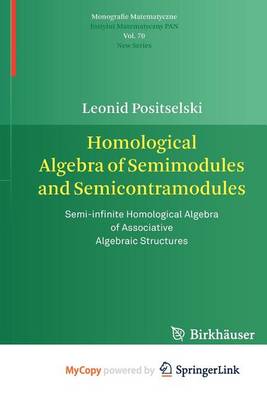Monografie Matematyczne
1 primary work • 2 total works
Book 70
Homological Algebra of Semimodules and Semicontramodules
by Leonid Positselski
Published 1 January 2010
ThesubjectofthisbookisSemi-In?niteAlgebra,ormorespeci?cally,Semi-In?nite Homological Algebra. The term "semi-in?nite" is loosely associated with objects that can be viewed as extending in both a "positive" and a "negative" direction, withsomenaturalpositioninbetween,perhapsde?nedupto a"?nite"movement. Geometrically, this would mean an in?nite-dimensional variety with a natural class of "semi-in?nite" cycles or subvarieties, having always a ?nite codimension in each other, but in?nite dimension and codimension in the whole variety [37]. (For further instances of semi-in?nite mathematics see, e. g. , [38] and [57], and references below. ) Examples of algebraic objects of the semi-in?nite type range from certain in?nite-dimensional Lie algebras to locally compact totally disconnected topolo- cal groups to ind-schemes of ind-in?nite type to discrete valuation ?elds. From an abstract point of view, these are ind-pro-objects in various categories, often - dowed with additional structures. One contribution we make in this monograph is the demonstration of another class of algebraic objects that should be thought of as "semi-in?nite", even though they do not at ?rst glance look quite similar to the ones in the above list.
These are semialgebras over coalgebras, or more generally over corings - the associative algebraic structures of semi-in?nite nature. The subject lies on the border of Homological Algebra with Representation Theory, and the introduction of semialgebras into it provides an additional link with the theory of corings [23], as the semialgebrasare the natural objects dual to corings.
These are semialgebras over coalgebras, or more generally over corings - the associative algebraic structures of semi-in?nite nature. The subject lies on the border of Homological Algebra with Representation Theory, and the introduction of semialgebras into it provides an additional link with the theory of corings [23], as the semialgebrasare the natural objects dual to corings.

